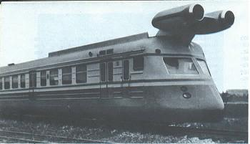
Turbojet train
Encyclopedia

Train
A train is a connected series of vehicles for rail transport that move along a track to transport cargo or passengers from one place to another place. The track usually consists of two rails, but might also be a monorail or maglev guideway.Propulsion for the train is provided by a separate...
powered by turbojet engines. Like a jet aircraft
Jet aircraft
A jet aircraft is an aircraft propelled by jet engines. Jet aircraft generally fly much faster than propeller-powered aircraft and at higher altitudes – as high as . At these altitudes, jet engines achieve maximum efficiency over long distances. The engines in propeller-powered aircraft...
, but unlike a gas turbine locomotive
Gas turbine locomotive
A Gas turbine locomotive is a locomotive powered by a gas turbine. The majority of gas turbine locomotives have had electric transmission but mechanical transmission has also been used, particularly in the early days. The advantage of using gas turbines is that they have very high power-to-bulk...
, the train is propelled by the jet thrust of the engines, rather than by by its wheels.
Only a handful of jet-powered trains have been built, for experimental research in high-speed rail
High-speed rail
High-speed rail is a type of passenger rail transport that operates significantly faster than the normal speed of rail traffic. Specific definitions by the European Union include for upgraded track and or faster for new track, whilst in the United States, the U.S...
. Gas turbine engines are small and light, compared to previous locomotive engines, turbojet trains, as well as most gas turbine train
Gas turbine train
A gas turbine train, is a passenger train that uses one or more gas turbines as its main source of power. Few passenger trains use this system today, although there has been one recent prototype built by Bombardier Transportation.-Description:...
s, have been built as railcars (combining propulsion and passenger accommodation) rather than as separate locomotives and accommodation.
M-497
The first attempt to use turbojet engines on a railroad was made by the New York Central RailroadNew York Central Railroad
The New York Central Railroad , known simply as the New York Central in its publicity, was a railroad operating in the Northeastern United States...
in 1966. Their railcar
Railcar
A railcar, in British English and Australian English, is a self-propelled railway vehicle designed to transport passengers. The term "railcar" is usually used in reference to a train consisting of a single coach , with a driver's cab at one or both ends. Some railways, e.g., the Great Western...
M-497
M-497 Black Beetle
The M-497 was an experimental jet-powered locomotive test bed of the New York Central Railroad corporation, developed and tested in 1966 in the United States of America...
was able to reach speeds up to 184 miles per hour (82.3 m/s).
ER22
Another turbojet railcar was built in the USSR in 1970. The ER22 was able to reach a speed of 250 kilometres per hour (155.3 mph). It had a mass of 54.4 metric tons (including 7.4 tons of fuel) and was 28 metres (91.9 ft) long. The power car was planned to be used as a part of "Russian troika" express.See also
- SchienenzeppelinSchienenzeppelinThe ' or rail zeppelin was an experimental railcar which resembles a zeppelin airship in appearance. It was designed and developed by the German aircraft engineer Franz Kruckenberg in 1929. Propulsion was by means of a propeller located at the rear, it accelerated the railcar to setting the land...
- A German propeller-driven railcar of 1929
- AérotrainAérotrainThe Aérotrain was a Hovertrain developed in France from 1965 to 1977. The lead engineer was Jean Bertin.The goal of the Aérotrain was similar to that of the magnetic levitation train: to suspend the train above the tracks so the only resistance is that of air resistance...
- Aérotrain
- A contemporary French hovercraft train, also powered by a jet engine

